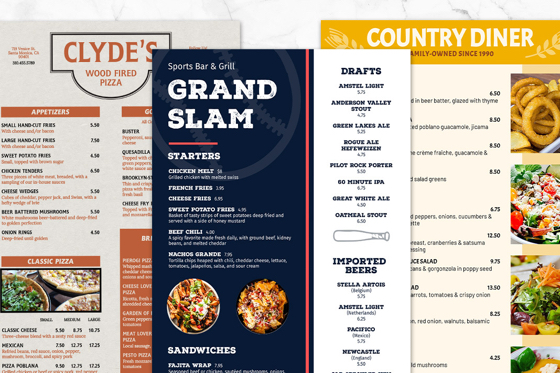Are you looking to maximize the menu at your hotel’s restaurant? There are many subtle design tricks that can influence your customers by steering their attention, stimulating their appetite and selling your prices.
Contributed by Mark Plumlee, MustHaveMenus, Ashland, Oregon
Before creating your next menu, give this list of tips a read to make sure that your menu design choices are sending the message you intend to customers.
Fun with fonts
Fonts can communicate information about your dish at a glance before customers even have the chance to read the name or description.
- Italics convey a perception of quality.
- Rounder typefaces are associated with sweeter tastes.
- While angular ones are associated with sourness or bitters.
- Wines labeled with a difficult-to-read font are more liked by drinkers
Color codes
Colors have powerful and often subconscious affects that you can use to subtlety influence customer decision-making.
- Greens imply healthy and fresh
- Oranges, reds and yellows are appetite stimulants
- Blues are refreshing and work well for drinks
- Red creates a sense of urgency, so you can use it to draw attention to high-margin items.

Pricing tricks
Small changes to how you present your prices can make expensive items seem more reasonable to customers.
- Drop the price by a cent – at a glance, $5.99 seems much more palatable than $6.
- Eliminate the dollar sign all together. Customers don’t need to be reminded that they’re spending money.
- Place higher-priced items at the top of sections to make the ones that follow seem less expensive
Menu real estate
Understanding how customers read a menu is important to figuring out how to arrange and place your high-margin items and promotions.
- Generally, customers read menus like they would a book – top left to bottom right.
- There are hot spots, however. Eye tracking studies have shown that people tend to look at the top right corner first. So, that’s the best place to put high-margin items or promotions you’d like to draw attention to.
- When it comes to long lists of menu items, you need to factor in customer attention span and decision fatigue. Split the menu into sections so customers aren’t overwhelmed. Three to seven items per section is the optimal range, but customers will take the time to read through more if you’re a fine dining establishment.
Visual signals
Colorful visuals can highlight and set apart the areas or menu items you want customers focusing on.
- Boxes, bursts, frames, underlines, logos and highlights are all effective ways to break up the text and signal to your customers that an item is worth their attention.
- Images can accomplish this as well, but there are more inherent risks. Pictures of food in a menu is often associated with fast food and cheaper chains. Plus, you run the risk of customers feeling disappointed when the dish doesn’t match the mouth-watering photo.
Names, descriptions
Strong adjectives and precise wording can act like a garnish for your menu items, dressing up bland names to make them unique and appealing.
- Giving menu items descriptive names can increase sales up to 27%, especially if the name alludes to the item’s origin or relation to your restaurant (“cookies” vs. “Grandma’s home-baked zucchini cookies”). It adds authenticity to the product which customers associate with quality.
- Extensive food descriptions with longer words give the impression of quality so customers are willing to pay more.
